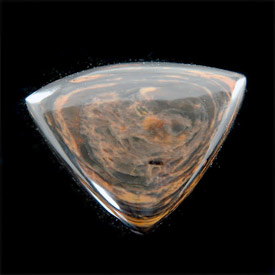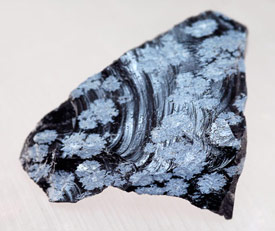| This stone is called mahogany obsidian due to the brown swirl patterns trapped within. It makes the stone appear somewhat wood-like. Stone cut by author.
The color layers in obsidian are due to mineral fragments that were oriented to the flow patterns while the obsidian was still flowing. Other types of obsidian have may have trapped water oriented to flow patterns or small air bubbles. There are many varieties with a multitude of names: sheen, rainbow, and velvet are well known.
Snowflake obsidian is the result of a process called "devitrification". Obsidian is not stable as it is a glass, and the silica will slowly crystallize from the glass to form a secondary material, the process produces the white silica mineral that creates the snowflake pattern.
The image below is a sample of rainbow obsidian with a light directed into the center. It is roughly actual size.
|



